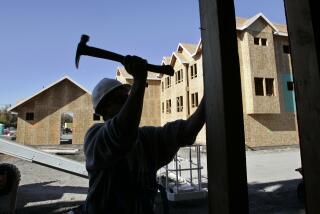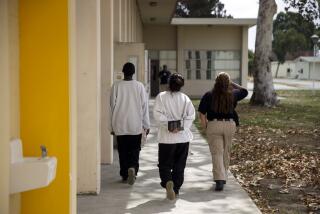Latino Youth Offenders Face Harsher Treatment, Study Finds
WASHINGTON — Latinos are detained in juvenile justice systems 1.5 times more often and are twice as likely to be incarcerated as their white peers, according to a national study released Thursday.
“Nationwide, there’s harsher treatment of Latino youth than white youth, even for the same offense,” said Mark Soler, president of Youth Law Center, a partner organization in the group that commissioned the study. “These are matters for concern.”
The concern extends to California--home to 11 million Latinos--where 48% of those in California Youth Authority lockups are Latino, according to state and federal figures. Moreover, the average stay for Latinos is longer: 34.3 months compared with 30.5 months for whites, and 37.4 months for blacks. The study released Thursday found that Latino youths from Los Angeles were arrested 2.3 times more often than whites, were tried as adults 2.4 times more often, and were imprisoned as adults 7.3 times more often than whites from 1996 to 1998.
The report was commissioned by Building Blocks for Youth, an alliance of children’s advocates, law enforcement officials and community organizers.
Several criminologists, as well as law enforcement and Latino rights’ officials, said they were not surprised by the findings. A complex mix of factors contributes to the high numbers, they said, including cultural differences, economic disadvantage, racial profiling and the lack of alternatives to gangs and crimes.
Raul Yzaquirre, president of the National Council of La Raza, said the report demonstrates “unfair treatment of Latinos in the juvenile justice system.” He added, “Our youth are denied equal opportunities and representation as a result of inadequate bilingual services and culturally insensitive environments.”
Sylvester Tellez, 20, who lives in the Pico-Union district, has firsthand experience with the system. His grandmother and father were in gangs, and he joined a gang at 12, he said. Four months later, he was arrested for possessing an Uzi submachine gun, the first of five run-ins with the law.
“You go to County Jail in L.A., or anywhere in the state, Latinos are the majority in any cell, in any dorm, in any yard,” said Tellez, who served two years for carjacking but now works as a job placement counselor at “Homies Without Needles,” a nonprofit youth counseling group, “I don’t have anything against it, but are they really going to know how to beat it when they get out?”
Franklin Zimring, a professor of criminology at UC Berkeley’s Boalt Hall School of Law, said some of California’s toughest streets--and toughest law enforcement--are found in Los Angeles, Bakersfield, Kern County and Fresno.
“The rates of Hispanic gang activity influence that,” Zimring said. Latinos are “the largest minority group in the toughest environment”--a reason for the disproportionate numbers.
That may result in a phenomenon known as “justice by geography.” Highly policed areas generate a higher number of police contacts and arrests, he and other experts said.
Creg Datig, the chief deputy district attorney for Riverside County, said that in predominantly Latino eastern part of the county, he often encounters young people from immigrant families in which both parents work and, left alone, they fall into trouble.
Most juvenile crimes are committed between 3 and 6 p.m., Datig said.
“It’s an unfortunate Catch-22. In their efforts to better themselves, these folks work so much that we see teenagers coming up [through the justice system]. I’m in court every day with them,” Datig said.
In California, each of the 240,000 juveniles arrested annually comes before a judge.
A convicted juvenile then goes before the Youthful Offender Parole Board. The board evaluates the offender and recommends detainment, mental health counseling, drug and alcohol treatment and education.
About 1% of all juvenile offenders who come before a judge wind up in California Youth Authority facilities, the most secure youth facilities in the state. The rest do time in county detention centers or camps.
“There’s no real targeting by race,” said Susan Wallace, executive director of the Youthful Offender Parole Board. “We are supposed to, and I hope we are dealing with these on a case-by-case basis. That’s the difference with the juvenile system: We’re interested in rehabilitation.”
According to the study, cultural factors play a role in the disproportionate Latino sentencing. Avoiding direct eye contact may suggest disrespect or deception to criminal justice professionals, but may be a sign of deference in the Latino community, the study suggests. A youngster from a migrant family may have difficulty staying in touch with his parole officer after release because the family moves often.
The study called on lawmakers to develop racially and ethnically unbiased risk and needs assessments. It urges the elimination of racial profiling, employing more bilingual and culturally sensitive workers, and collecting data that accurately distinguish between Latinos and youth offenders of other races.
Tellez said the toughest problem teenagers face in his neighborhood is the lack of alternatives to crime. “When you turn around and there aren’t any youth centers, and there’s nothing but gangs, and you’re from a third-generation gang family, you start thinking it’s normal stuff.”
More to Read
Sign up for Essential California
The most important California stories and recommendations in your inbox every morning.
You may occasionally receive promotional content from the Los Angeles Times.










